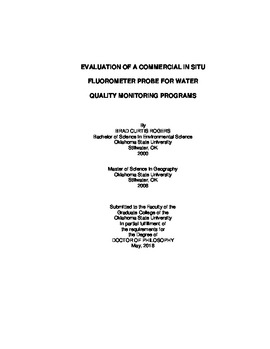| dc.contributor.advisor | Storm, Daniel E. | |
| dc.contributor.author | Rogers, Brad Curtis | |
| dc.date.accessioned | 2019-05-08T19:52:50Z | |
| dc.date.available | 2019-05-08T19:52:50Z | |
| dc.date.issued | 2018-05 | |
| dc.identifier.uri | https://hdl.handle.net/11244/319640 | |
| dc.description.abstract | Benthic Algae is often used in water quality monitoring; however, traditional methods of benthic algae assessment are relatively expensive and time consuming. The Benthotorch® is a portable fluorimeter probe used to measure in situ benthic chlorophyll-a (µg/cm2) and relative abundance of cyanobacteria, green algae and diatoms (cells/cm2) in about 20 seconds. During the summer of 2014, at 42 locations across Oklahoma, 119 benthic algae samples were measured with the Benthotorch®, extracted for chlorophyll a and a taxonomic assessment conducted. Medians for each method were statistically similar based on Mann Whitney tests. Regression analyses resulted in significant and positive correlations between BenthoTorch® chlorophyll a estimates and extracted chlorophyll a, although BenthoTorch® estimates underestimated extracted chlorophyll a. The most likely causes of discrepancies between the extracted chlorophyll a and the BenthoTorch® were self-shading of the algae, high biomass concentrations and sediments present in the samples. The BenthoTorch® measured an area of 1.0 cm2 while the field samples were collected from an area of 13.1 cm2, which is another error source. To test this, benthic algae was grown under controlled conditions in a laboratory. After a period of growth, the benthic algae was measured in situ, ex situ/in vivo with the BenthoTorch® and compared to extracted chlorophyll a measured with a spectrophotometer. The results were improved over field tests with an R2 of 0.64 and a slope of 0.86 for the in situ and R2 of 0.79 and a slope of 0.81 for the modified method. Tests for variance of sampler size concluded that the larger sampler area improved characterizing the algal variability. BenthoTorch® estimates of relative abundance were evaluated, were statistically different based on Mann Whitney tests, and were not significantly correlated in regression analyses. | |
| dc.format | application/pdf | |
| dc.format | application/vnd.ms-excel | |
| dc.language | en_US | |
| dc.rights | Copyright is held by the author who has granted the Oklahoma State University Library the non-exclusive right to share this material in its institutional repository. Contact Digital Library Services at lib-dls@okstate.edu or 405-744-9161 for the permission policy on the use, reproduction or distribution of this material. | |
| dc.title | Evaluation of a commercial in situ fluorometer probe for water quality monitoring programs | |
| dc.contributor.committeeMember | Dzialowski, Andrew R. | |
| dc.contributor.committeeMember | Henley, William J. | |
| dc.contributor.committeeMember | Frazier, Amy E. | |
| osu.filename | Rogers_okstate_0664D_15574.pdf | |
| osu.accesstype | Open Access | |
| dc.type.genre | Dissertation | |
| dc.type.genre | Numeric Data | |
| dc.type.material | Text | |
| dc.type.material | Dataset | |
| thesis.degree.discipline | Environmental Science | |
| thesis.degree.grantor | Oklahoma State University | |
